Consumer Carbon Footprint of Fashion E-Commerce: A Comparative Analysis Between Omnichannel and Pure-Player Models in Spain
Abstract
1. Introduction
- RQ1. What is the per-purchase carbon footprint of click-and-collect (TENDAM omnichannel) versus pure-player home delivery for fashion apparel in Spain?
- RQ2. How does that footprint vary across large (>1 M inhabitants), medium (0.5–1 M), and small (<0.5 M) cities?
- RQ3. How does store capillarity influence the results obtained?
Literature Review
2. Materials and Methods
2.1. Study Design and Setting
2.2. Sample and Data Collection
2.3. Greenhouse Gas Emissions Calculation
2.4. Mapping Store Influence Areas with Intelligent Algorithms
2.5. Statistical Analysis
2.6. Ethical Considerations
3. Results
4. Discussion
5. Conclusions
Author Contributions
Funding
Institutional Review Board Statement
Informed Consent Statement
Data Availability Statement
Acknowledgments
Conflicts of Interest
Abbreviations
| Carbon Dioxide Equivalent | |
| DGC | Dirección General de Circulación |
| Distance traveled by customer i (km) | |
| ) | |
| GHG | Greenhouse Gas |
| IDAE | Instituto para la Diversificación y el Ahorro de la Energía |
| Emission factor associated with the transport mode of customer i (g) | |
| LCA | Life Cycle Assessment |
| , ∈{1,2} | |
| RQ | Research Question |
| Time taken to reach the store by customer i (hours) | |
| Average speed for customer i according to city and transport mode (km/h) |
Appendix A
References
- World Commission on Environment and Development (WCED). Our Common Future; Oxford University Press: Oxford, UK, 1987. [Google Scholar]
- Purvis, B.; Mao, Y.; Robinson, D. Three pillars of sustainability: In search of conceptual origins. Sustain. Sci. 2019, 14, 681–695. [Google Scholar] [CrossRef]
- World Economic Forum. The Future of the Last-Mile Ecosystem. Available online: https://www.weforum.org/publications/ (accessed on 20 July 2025).
- World Economic Forum. Urban Deliveries Expected to Add 11 Minutes to Daily Commute and Increase Carbon Emissions by 30% Until 2030 Without Effective Intervention. Available online: https://www.weforum.org/ (accessed on 20 July 2025).
- Liyi, Z.; Chun, L. A Comparative Study of Environment Impact in Distribution via E-Commerce and Traditional Business Model. In Proceedings of the 5th International Conference on New Trends in Information Science and Service Science, Macao, China, 24–26 October 2011; pp. 194–199. [Google Scholar]
- Cullinane, S.; Cullinane, K. The Logistics of Online Clothing Returns in Sweden and How to Reduce its Environmental Impact. J. Serv. Sci. Manag. 2021, 14, 72–95. [Google Scholar] [CrossRef]
- Sarkar, M. Last-Mile Carbon Emission under E-Commerce: Environmental Perspective. Open J. Soc. Sci. 2023, 11, 277–292. [Google Scholar] [CrossRef]
- Dubisz, D.; Golinska-Dawson, P.; Zawodny, P. Measuring CO2 Emissions in E-Commerce Deliveries: From Empirical Studies to a New Calculation Approach. Sustainability 2022, 14, 16085. [Google Scholar] [CrossRef]
- Buldeo Rai, H.; Touami, S.; Dablanc, L. Not All E-commerce Emits Equally: Systematic Quantitative Review of Online and Store Purchases’ Carbon Footprint. Environ. Sci. Technol. 2023, 57, 708–718. [Google Scholar] [CrossRef] [PubMed]
- Makov, T.; Roichman, R.; Sprecher, B.; Blass, V.; Meshulam, T. The Hidden Environmental Costs of Consumer Product Returns. Unpublished work. 2023. [Google Scholar]
- Roichman, R.; Sprecher, B.; Blass, V.; Meshulam, T.; Makov, T. The convenience economy: Product flows and GHG emissions of returned apparel in the EU. Resour. Conserv. Recycl. 2024, 210, 107811. [Google Scholar] [CrossRef]
- Brown, J.R.; Guiffrida, A.L. Carbon emissions comparison of last mile delivery versus customer pickup. Int. J. Logist. Res. Appl. 2014, 17, 503–521. [Google Scholar] [CrossRef]
- Edwards, J.B.; McKinnon, A.C.; Cullinane, S.L. Comparative analysis of the carbon footprints of conventional and online retailing: A “last mile” perspective. Int. J. Phys. Distrib. Logist. Manag. 2010, 40, 103–123. [Google Scholar] [CrossRef]
- Nabot, A.; Omar, F. Comparative Study of the Impacts of Conventional and Online Retailing on the Environment: A Last Mile Perspective. Int. J. Comput. Appl. 2016, 138, 6–12. [Google Scholar] [CrossRef]
- Feichtinger, S.; Gronalt, M. The Environmental Impact of Transport Activities for Online and In-Store Shopping: A Systematic Literature Review to Identify Relevant Factors for Quantitative Assessments. Sustainability 2021, 13, 2981. [Google Scholar] [CrossRef]
- Gutenschwager, K.; Rabe, M.; Chicaiza-Vaca, J. Comparing Direct Deliveries and Automated Parcel Locker Systems with Respect to Overall CO2 Emissions for the Last Mile. Algorithms 2023, 17, 4. [Google Scholar] [CrossRef]
- Raza, S.A.; Govindaluri, S.M. Omni-channel retailing in supply chains: A systematic literature review. Benchmarking Int. J. 2021, 28, 2605–2635. [Google Scholar] [CrossRef]
- Luo, L.; Sheng, Y.; Song, Y. A Historical Review on Omni Channel Retailing Consumer Research. Oper. Supply Chain Manag. Int. J. 2023, 16, 435–449. [Google Scholar] [CrossRef]
- Velazquez, R.; Chankov, S.M. Environmental impact of last mile deliveries and returns in fashion E-commerce: A cross-case analysis of six retailers. In Proceedings of the 2019 IEEE International Conference on Industrial Engineering and Engineering Management (IEEM), Macao, China, 15–18 December 2019; pp. 1099–1103. [Google Scholar] [CrossRef]
- Schnieder, M.; Hinde, C.; West, A. Land Efficient Mobility and Emissions: Click and Collect vs. Grocery Deliveries in Switzerland. Sustainability 2023, 15, 8814. [Google Scholar] [CrossRef]
- Beziat, A.; François, C. Impacts of Behavioral, Organizational, and Spatial Factors on the Carbon Footprint of Traditional Retail and E-commerce in the Paris Region. Environ. Sci. Technol. 2024, 58, 7325–7334. [Google Scholar] [CrossRef]
- Vhatkar, M.S.; Raut, R.D.; Gokhale, R.; Cheikhrouhou, N.; Akarte, M. A glimpse of the future sustainable digital omnichannel retailing emerges—A systematic literature review. J. Clean. Prod. 2024, 442, 141111. [Google Scholar] [CrossRef]
- Lerner, J.; Calloway, C.; Ason, D. Carbon reduction and understanding through simulation of transportation (CRUST) for e-commerce. J. Clean. Prod. 2024, 454, 142198. [Google Scholar] [CrossRef]
- Prasertwit, T.; Kanchanasuntorn, K.; Vongmanee, V. Development of a Green E-Commerce Model and Analysis of Carbon Footprints Adoption. Hong Kong J. Soc. Sci. 2023, 62, 273–282. [Google Scholar] [CrossRef]
- Sharma, A.P.; Starčević, S.; Saha, R. Determinants of customer buying behaviour in omnichannel retailing: A systematic literature review and future research directions. J. Serv. Theory Pract. 2024, 34, 822–863. [Google Scholar] [CrossRef]
- Escursell, S.; Llorach-Massana, P.; Roncero, M.B. Sustainability in e-commerce packaging: A review. J. Clean. Prod. 2021, 280, 124314. [Google Scholar] [CrossRef]
- Mansurali, A.; Stephen, G.; Kasilingam, D.; Inbaraj Jublee, D. Omnichannel marketing: A systematic review and research agenda. Int. Rev. Retail Distrib. Consum. Res. 2024, 34, 616–645. [Google Scholar] [CrossRef]
- Wiese, A. Sustainability in Retailing: Environmental Effects of Transport Processes, Shopping Trips and Related Consumer Behaviour. Ph.D. Thesis, University of Göttingen, Göttingen, Germany, 2013. [Google Scholar]
- Wiese, A.; Toporowski, W.; Zielke, S. Transport-related CO2 effects of online and brick-and-mortar shopping: A comparison and sensitivity analysis of clothing retailing. Transp. Res. Part D Transp. Environ. 2012, 17, 473–477. [Google Scholar] [CrossRef]
- Metropolis, N.; Ulam, S. The Monte Carlo Method. J. Am. Stat. Assoc. 1949, 44, 335–341. [Google Scholar] [CrossRef]
- Statista. Textiles—Worldwide. 2024. Available online: https://www.statista.com/outlook/io/manufacturing/material-products/textiles/worldwide (accessed on 16 September 2025).
- Risberg, A. A systematic literature review on e-commerce logistics: Towards an e-commerce and omni-channel decision framework. Int. Rev. Retail Distrib. Consum. Res. 2023, 33, 67–91. [Google Scholar] [CrossRef]
- Kalkha, H.; Bahnasse, A.; Ouajji, H. The rising trends of smart e-commerce. IEEE Access 2023, 11, 33839–33857. [Google Scholar] [CrossRef]
- Maximize Market Research (MMR). Textile Market: Global Industry Analysis and Forecast (2025–2032). Available online: https://www.maximizemarketresearch.com/market-report/textile-market/200298/ (accessed on 16 September 2025).
- Budimir, A.; Knežević, B. What influences young adult females when choosing an online apparel retailer: An exploratory analysis. In Proceedings of the ENTRENOVA–Enterprise Research Innovation Conference, Dubrovnik, Croatia, 14–16 September 2023. [Google Scholar] [CrossRef]
- Patwary, S.U. Consumer clothing behavior and associated environmental impact. Unpublished work. 2019. [Google Scholar] [CrossRef]
- Safeer, A.; Hussain, I.; Abrar, M.; Shabbir, R. Omnichannel retailing in light of psychological factors: A mediated model. Psychol. Res. Behav. Manag. 2023, 16, 5069–5088. [Google Scholar] [CrossRef]
- Huang, J.; Thoo, A.C.; Lo, Y.T. Systematic review of consumer behavior research in the context of green apparel. Int. J. Acad. Res. Bus. Soc. Sci. 2024, 14, 20575. [Google Scholar] [CrossRef]
- Bianchi, C.; Birtwistle, G. Consumers’ attitudes to sustainable fashion: A consumer behaviour perspective. J. Fash. Mark. Manag. 2010, 14, 256–271. [Google Scholar]
- Abdelmeguid, A.; Afy-Shararah, M.; Salonitis, K. Towards circular fashion: Management strategies promoting circular behaviour along the value chain. Sustain. Prod. Consum. 2024, 48, 143–156. [Google Scholar] [CrossRef]
- Siebert, F.; Costa Gonçalves, J. Socio-environmental impacts of the textile chain: Consumer knowledge. Int. J. Adv. Res. 2023, 13, 73–89. [Google Scholar] [CrossRef]
- Klein, P.; Popp, B. A comparison of the environmental sustainability of brick-and-mortar retailing and online retailing: Contrasting academic research and consumer perceptions. Bus. Soc. Rev. 2023, 128, 635–660. [Google Scholar] [CrossRef]
- Kamaruddin, S.S.; Ahmad, F.K.; Wahab, A.A.; Aji, Z.M.; Nordin, N. E-commerce carbon footprint contribution: A preliminary investigation framework. In Proceedings of the 9th International conference, ICOCI 2023, Kuala Lumpur, Malaysia, 13–15 September 2023. [Google Scholar] [CrossRef]
- Li, Z.; Zhou, Y.; Guan, D.; Yang, Z. The carbon footprint of fast fashion consumption and mitigation strategies—A case study of jeans. Sci. Total Environ. 2024, 924, 171508. [Google Scholar] [CrossRef] [PubMed]
- Fares, N.; Lloret, J.; Kumar, V.; Frederico, G.F. Factors affecting omnichannel buying online and return in store: Evidence from fast-fashion retail. J. Enterp. Inf. Manag. 2023, 36, 952–978. [Google Scholar] [CrossRef]
- Maier, E.; Bornschein, R.; Manss, R.; Hesse, D. Financial consequences of adding bricks to clicks. Int. J. Res. Mark. 2023, 40, 609–628. [Google Scholar] [CrossRef]
- Kantar. El Sector de la Moda y la Actitud del Consumidor Frente al Medio Ambiente. Ediciones Sibila: 2024. Available online: https://edicionessibila.com/wp-content/uploads/2024/11/28-nov-24-KANTAR_Estudio-sostenibilidad-Moda-Espana-2024-PRESENTADO.pdf (accessed on 16 September 2025).
- Hauschild, C.; Coll, A. The influence of technologies in increasing transparency in textile supply chains. Logistics 2023, 7, 55. [Google Scholar] [CrossRef]
- Van Rossum, G.; Drake, F.L. Python 3 Reference Manual; CreateSpace: Scotts Valley, CA, USA, 2009; Available online: https://dl.acm.org/doi/10.5555/1593511 (accessed on 17 September 2025).
- Google. Google Colaboratory. 2025. Available online: https://colab.research.google.com/ (accessed on 16 July 2025).
- Instituto Nacional de Estadística. Annual Population Census. Gobierno de España-Ministerio de Economía, Comercio y Empresa: 2024. Available online: https://www.ine.es/dyngs/INEbase/operacion.htm?c=Estadistica_C&cid=1254736176992&idp=1254735572981 (accessed on 18 September 2025).
- DGC Serie Histórica de Mapas de Movilidad. Gobierno de España–Ministerio de Transportes y Movilidad Sostenible: 2023. Available online: https://www.transportes.gob.es/carreteras/nuestra-red/movilidad/mapas-trafico/serie-historica-mapas (accessed on 17 September 2025).
- IDAE Base de datos de Consumo y Emisiones de CO2. Gobierno de España–Ministerio para la Transición Ecológica y el Reto Demográfico: 2025. Available online: https://coches.idae.es/consumo-de-carburante-y-emisiones#:~:text=Por%20cada%20litro%20de%20gasolina,64%20kg%20de%20CO2 (accessed on 17 September 2025).
- Metro de Madrid. Reducimos la huella de carbono. Community of Madrid: 2020. Available online: https://www.metromadrid.es/es/nota-de-prensa/2020-08-25/reducimos-un-26-la-huella-de-carbono-en-metro-de-madrid-y-revalidamos-nuestra-certificacion (accessed on 17 September 2025).
- Story, R. Folium, Version 0.20.0. 2024. Available online: https://python-visualization.github.io/folium/ (accessed on 17 September 2025).
- Spain. Law 14/2007, of July 3, on Biomedical Research. Available online: https://www.boe.es/buscar/doc.php?id=BOE-A-2007-12945 (accessed on 17 September 2025).
- Fowler, F.J. Survey Research Methods; SAGE Publications: Thousand Oaks, CA, USA, 2014. [Google Scholar]
- Rosas, D.A.; Padilla-Zea, N.; Burgos, D. Validated questionnaires in flow theory: A systematic review. Electronics 2023, 12, 2769. [Google Scholar] [CrossRef]
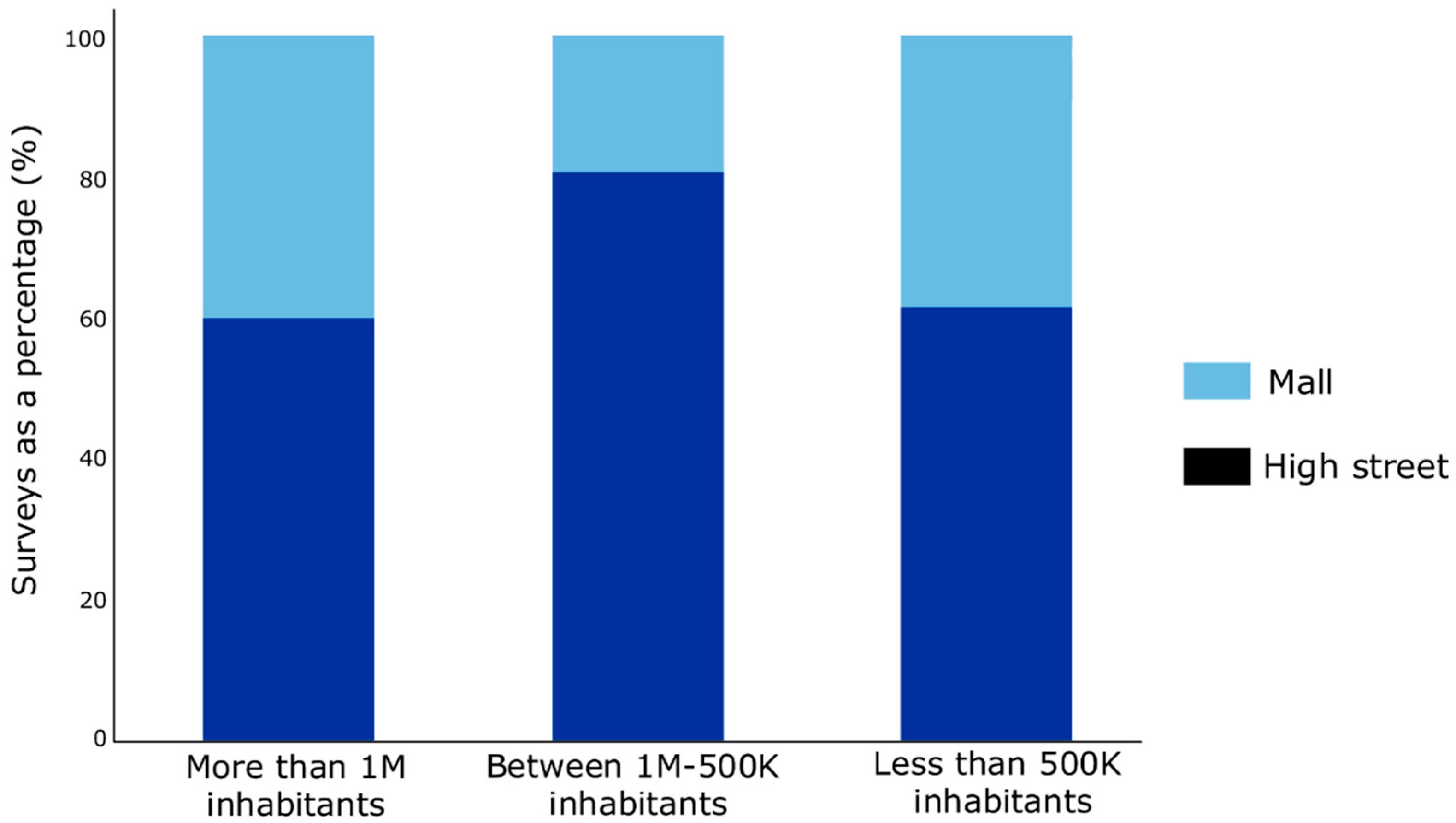

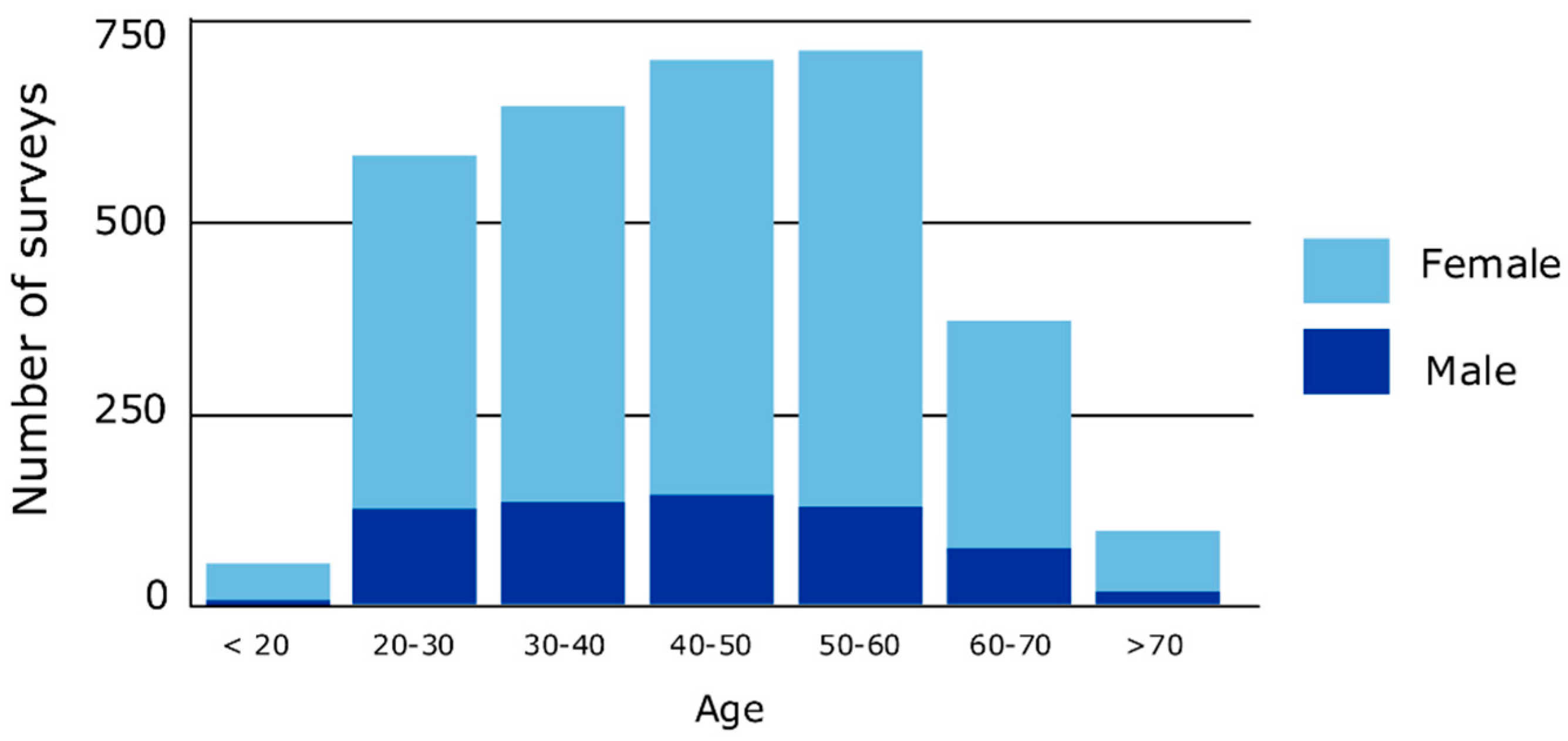

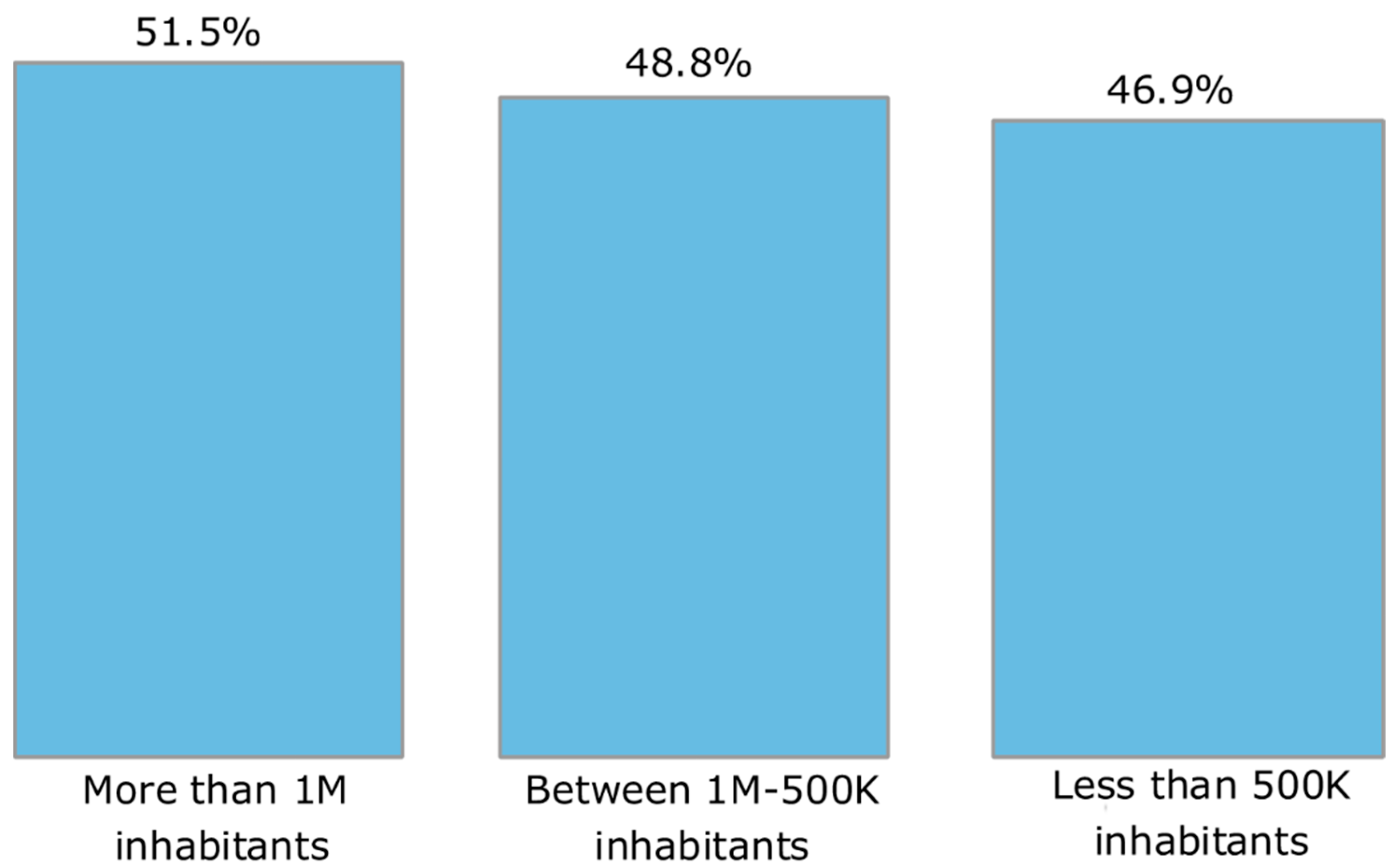

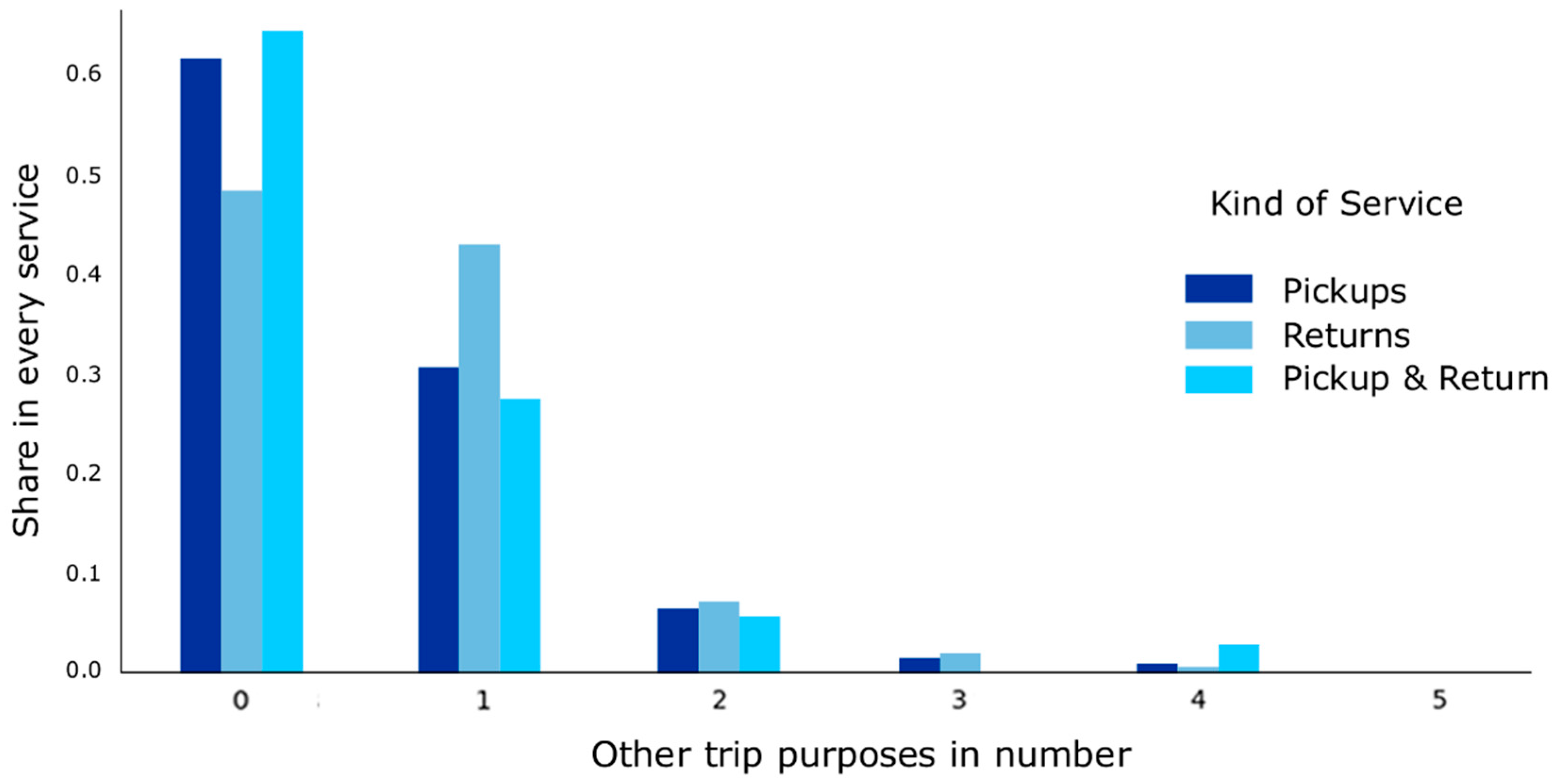
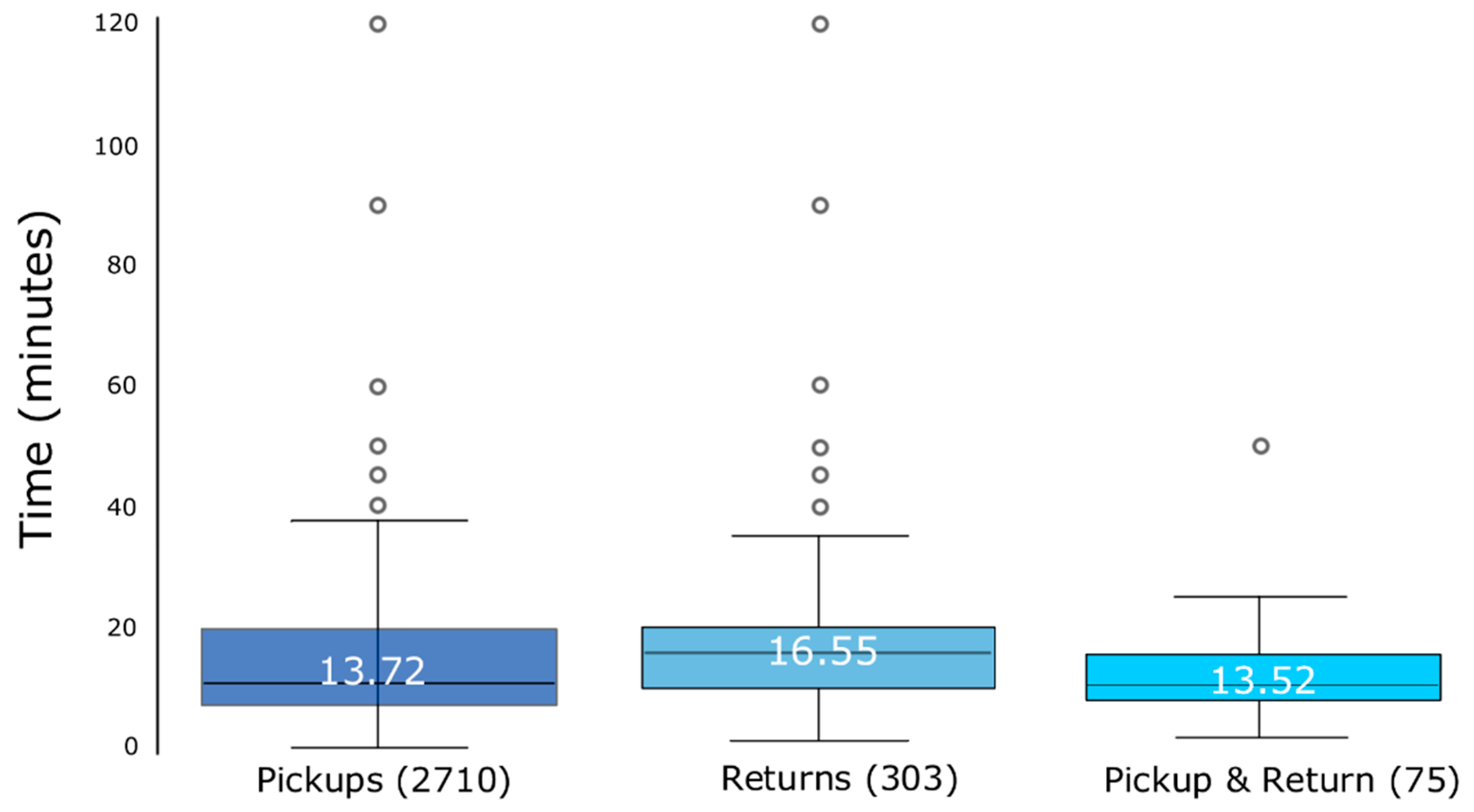

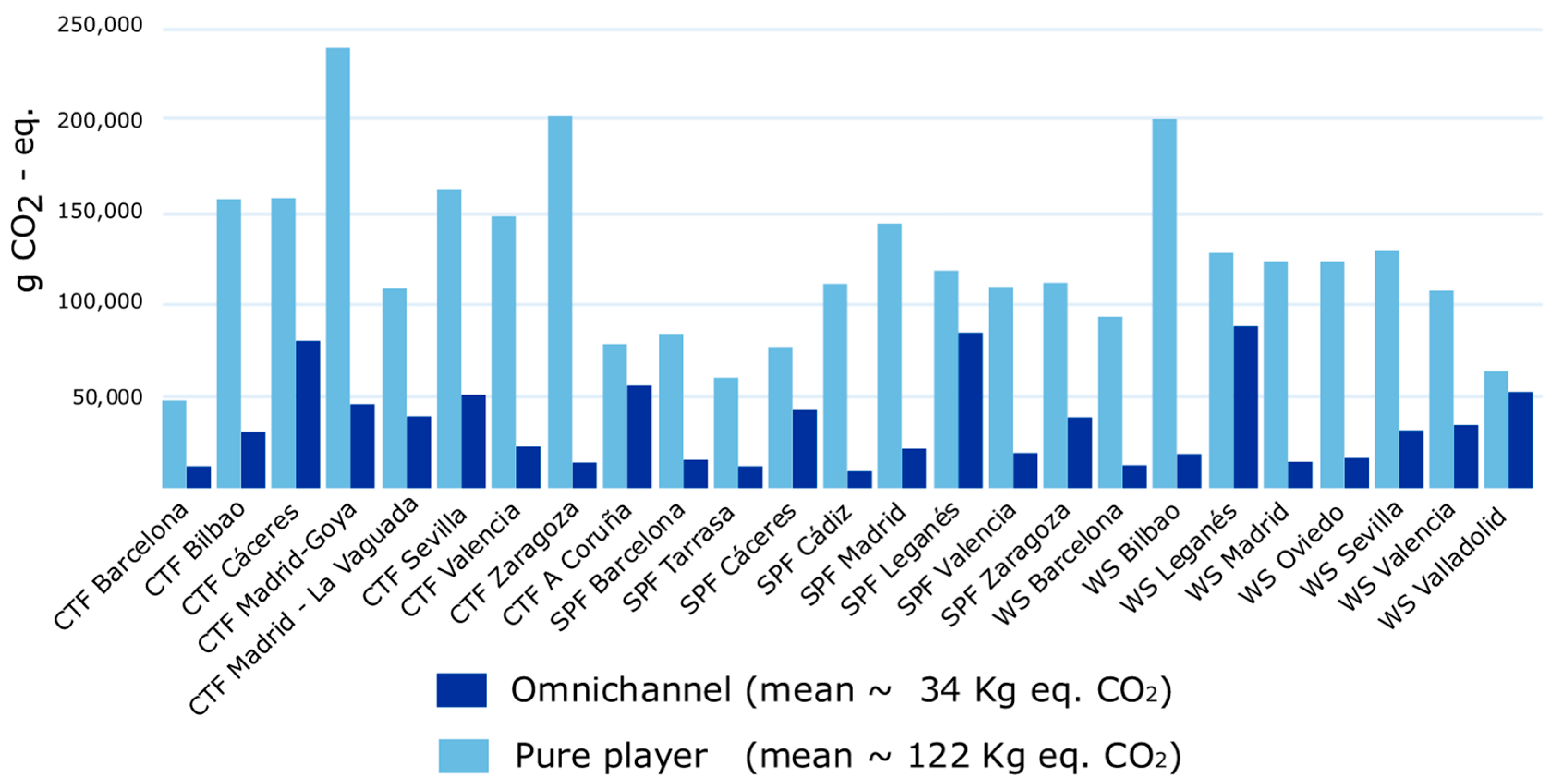
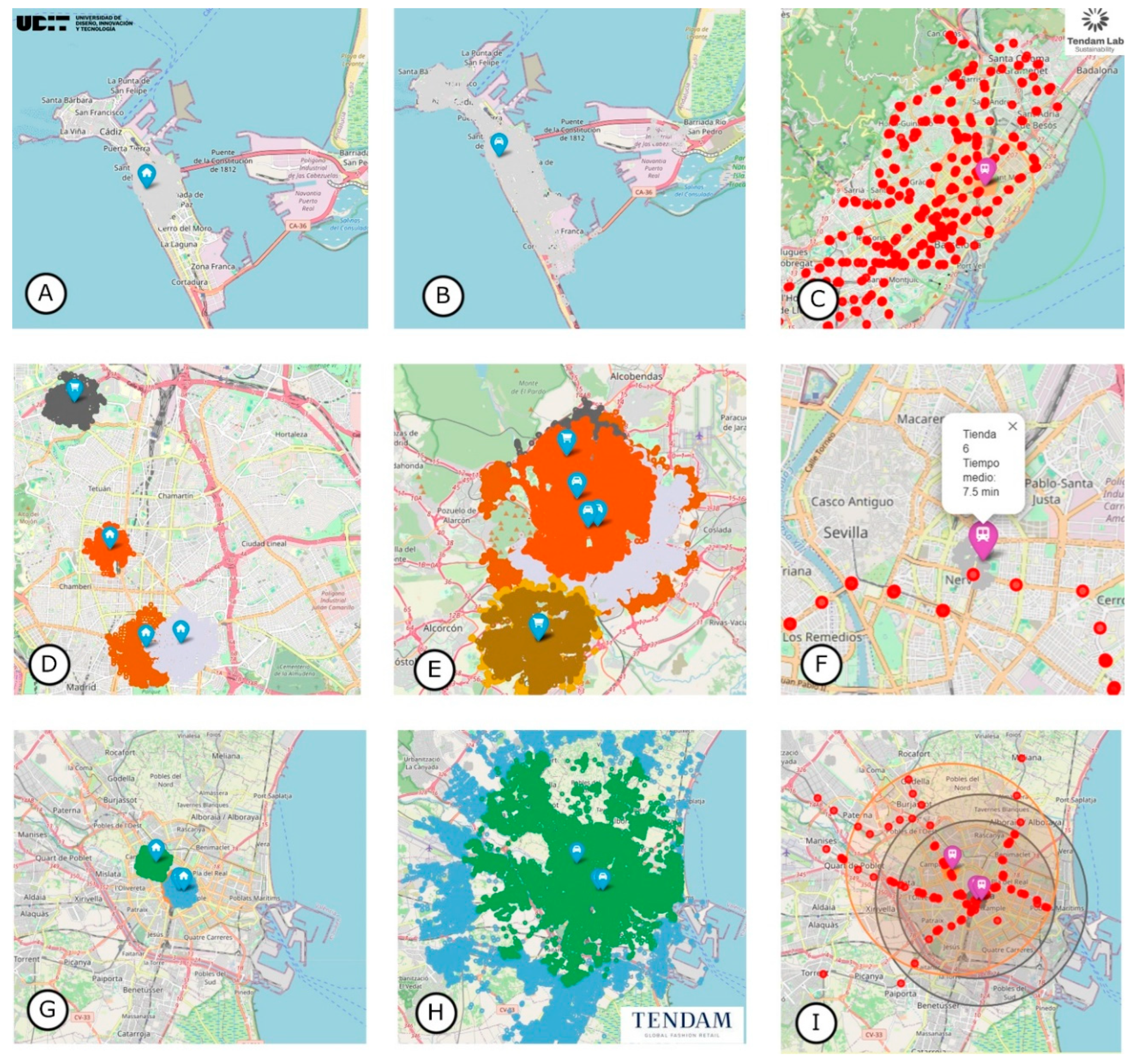
| Threshold | City | Population [51] | Surveys | Total | % |
|---|---|---|---|---|---|
| Large >1,000,000 inh. | Madrid | 3,416,771 | 869 | 1163 | 37.4 |
| Barcelona | 1,702,547 | 294 | |||
| Medium 500,000–1,000,000 inh. | Valencia | 825,948 | 373 | 975 | 31.4 |
| Sevilla | 687,488 | 279 | |||
| Zaragoza | 686,986 | 323 | |||
| Small <500,000 inh. | Bilbao | 348,089 | 368 | 968 | 31.2 |
| Valladolid | 300,618 | 65 | |||
| Oviedo | 224,883 | 119 | |||
| A Coruña | 111,180 | 67 | |||
| Cádiz | 111,180 | 111 | |||
| Cáceres | 96,215 | 238 | |||
| 3106 |
| Domain | Variable |
|---|---|
| Geography | City Madrid, Barcelona, Valencia, Sevilla, Zaragoza, Bilbao, Valladolid, Oviedo, A Coruña, Cádiz, Cáceres Store Cortefiel, Women’secret, Springfield |
| Mobility | Mode of transport walking, car, taxi, train, e-bike/e-scooter, subway, motorbike, bus |
| Car type diesel, gasoline, electric, hybrid, other | |
| Travel time minutes | |
| Behavior | Channel click and collect, return, booth |
| Trip Chaining | Other activities to do |
| Number of other activities | |
| Demography | Age, gender |
| City | Average Speed (City Center) |
|---|---|
| Madrid | 24 km/h |
| Barcelona | 21 km/h |
| Valencia | 25 km/h |
| Sevilla | 20 km/h |
| Zaragoza | 19 km/h |
| Bilbao | 28 km/h |
| Valladolid | 23 km/h |
| A Coruña | 20 km/h |
| Oviedo | 21 km/h |
| Cádiz | 18 km/h |
| Cáceres | 17 km/h |
| Fuel Type | Consumption per 100 km | K (g CO2-eq/km) |
|---|---|---|
| Diesel | 6–7 L | 261 |
| Gasoline | 7–8 L | 230 |
| Electric | 15–20 kWh | 75 |
| Plug-in Hybrid | 3–4 L + 15–20 kWh | 100 |
| Gas | 8–10 L | 166 |
| Mode of Transport | K (g CO2-eq/km) |
|---|---|
| Metro | 27.99 |
| Bus | 49 |
| Electric scooter | 25 |
| Motorcycle | 53 |
| Electric motorcycle | 17 |
| Electric bicycle | 3 |
| Train | 14 |
| Service | Minimum | Maximum | Average |
|---|---|---|---|
| Collection | 770 | 1500 | 1137 |
| Return | 1000 | 2000 | 1500 |
| Collection and return | 1800 | 3000 | 2400 |
| Test | Collection (n = 2726) | Return (n = 304) | Collection and Return (n = 76) |
|---|---|---|---|
| Inconsistent responses | 0 | 1 | 0 |
| Uncommon responses | 2726 | 304 | 76 |
| Repetitive patterns | 0 | 0 | 0 |
| Parameter | Pickups vs. Returns | Pickups vs. Both | Returns vs. Both |
|---|---|---|---|
| Chi-squared | 18.55 | 0.194 | 5.695 |
| P-value | 0.0000164 | 0.65 | 0.017 |
| Effect size | 0.07 | 0.008 | 0.122 |
| Statistical power | 0.99 | 0.07 | 0.665 |
| Service | Omnichannel | Pure Players |
|---|---|---|
| Pickups | 170–280 | 770–1000 |
| Returns | 280–600 | 1000–2000 |
| Pickup and Return | 446–513 | 1800–3000 |
Disclaimer/Publisher’s Note: The statements, opinions and data contained in all publications are solely those of the individual author(s) and contributor(s) and not of MDPI and/or the editor(s). MDPI and/or the editor(s) disclaim responsibility for any injury to people or property resulting from any ideas, methods, instructions or products referred to in the content. |
© 2025 by the authors. Licensee MDPI, Basel, Switzerland. This article is an open access article distributed under the terms and conditions of the Creative Commons Attribution (CC BY) license (https://creativecommons.org/licenses/by/4.0/).
Share and Cite
Rosas, D.A.; Lli-Torrabadella, C.; Tamames-Sobrino, M.; Miguel-Corbacho, I.; Olazagoitia, J.L. Consumer Carbon Footprint of Fashion E-Commerce: A Comparative Analysis Between Omnichannel and Pure-Player Models in Spain. Sustainability 2025, 17, 8690. https://doi.org/10.3390/su17198690
Rosas DA, Lli-Torrabadella C, Tamames-Sobrino M, Miguel-Corbacho I, Olazagoitia JL. Consumer Carbon Footprint of Fashion E-Commerce: A Comparative Analysis Between Omnichannel and Pure-Player Models in Spain. Sustainability. 2025; 17(19):8690. https://doi.org/10.3390/su17198690
Chicago/Turabian StyleRosas, David Antonio, Carlos Lli-Torrabadella, María Tamames-Sobrino, Irene Miguel-Corbacho, and José Luis Olazagoitia. 2025. "Consumer Carbon Footprint of Fashion E-Commerce: A Comparative Analysis Between Omnichannel and Pure-Player Models in Spain" Sustainability 17, no. 19: 8690. https://doi.org/10.3390/su17198690
APA StyleRosas, D. A., Lli-Torrabadella, C., Tamames-Sobrino, M., Miguel-Corbacho, I., & Olazagoitia, J. L. (2025). Consumer Carbon Footprint of Fashion E-Commerce: A Comparative Analysis Between Omnichannel and Pure-Player Models in Spain. Sustainability, 17(19), 8690. https://doi.org/10.3390/su17198690







